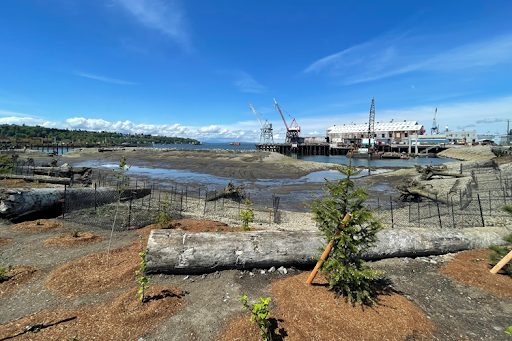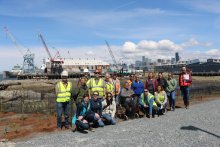Southwest Yard Habitat Project Complete: Fish and Wildlife Habitat Restored in a Highly Industrialized Area in Seattle, WA
July 18, 2023
This spring, Vigor Industrial LLC (Vigor) finished construction of the Southwest Yard Habitat Project to restore habitat for Chinook salmon, migratory birds, and other species living in and adjacent to the Lower Duwamish River.
This 2.7-acre project benefits natural resources including fish, shorebirds, and other wildlife that were injured from direct or indirect exposure to releases of hazardous substances and/or discharges of oil in this industrial waterway over decades.
This project was created in one of the most habitat limited areas of the river, Harbor Island. Vigor decommissioned part of a working waterway slip and transformed the area into integrated off-channel marsh, intertidal, and riparian habitat that will help support the recovery of these injured resources. This project was developed and constructed as required by a natural resource damage assessment (NRDA) settlement between members of the Elliott Bay Trustee Council and Vigor Industrial LLC and Exxon Mobil Corporation in May 2021. On behalf of Vigor, the habitat project was designed by Floyd|Snider, KPFF Consulting Engineers, and JA Brennan Associates, and constructed by Orion Marine Contractors.
As part of the habitat construction, Vigor first removed existing overwater structures, including docks and creosote pilings. They also integrated contaminated sediment removal into the process, which was required under separate Superfund cleanup requirements overseen by the U.S. Environmental Protection Agency. Then, Vigor regraded the site to create an off-channel habitat area to be used by fish to feed and rest. A protective berm was constructed to protect the off-channel habitat area from wave action along the West Waterway, and a migration corridor was constructed outside of the protective berm to allow for fish to more easily access the off-channel habitat.
This project is a major milestone for the Elliott Bay Trustee Council, a group of state and federal agencies and Tribes conducting NRDA activities and restoring habitat in Elliott Bay and the Lower Duwamish River. Members of the Elliott Bay Trustee Council include the National Oceanic and Atmospheric Administration (NOAA), the U.S. Department of the Interior, the Muckleshoot Indian Tribe, the Suquamish Indian Tribe, and the State of Washington.
In May of this year, the Trustee Council visited the site to see the completed restoration project, which includes:
- A large off-channel habitat area that is flooded twice a day
- A shallow water area called a “habitat bench” that provides a migration corridor for fish to access the site
- Large wood lining the shoreline of the off-channel habitat area
- Marsh vegetation planted in the intertidal zone
- Riparian vegetation planted along the perimeter of the project
- Structures along the waterway opening to allow for Tribal fishing net attachments.
While construction is now complete, the habitat will take 10 or more years to reach full function. The marsh and riparian plantings need to grow and take root to withstand tidal inundation and animal grazing. The off-channel mudflat needs to become colonized by benthic invertebrates that will become a food source for migrating salmon, migratory birds, and other resources. But even in this early stage, salmon have already been observed using this newly restored habitat in this industrial area of the river significantly lacking these features.
As part of the project, Vigor will also restrict shipyard vessel activity in the project’s vicinity, with an emphasis on limiting activity from March 1 through June 30 of each year, to reduce impacts to migrating salmon. Vigor will also perform 10 years of active maintenance and monitoring to ensure habitat establishment. After this 10-year period, Vigor will continue to perform maintenance and provide long-term stewardship of the site.
The Southwest Yard Habitat Project also creates a unique opportunity to increase our understanding of the impact of habitat restoration on salmon and their food sources within an industrial landscape. Through a partnership between Vigor, the University of Washington’s Wetland Ecosystem Team, and Long Live the Kings, a team of scientists are monitoring habitat function before and after restoration to understand any changes that may occur in the quantity of vegetation, insects, and fish at the site. This research should help inform future restoration efforts along working waterfronts and support further efforts towards salmon recovery.







